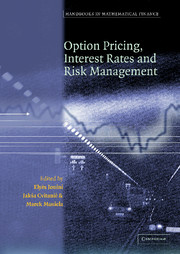Book contents
- Frontmatter
- Contents
- List of Contributors
- Introduction
- Part one Option Pricing: Theory and Practice
- Part two Interest Rate Modeling
- Part three Risk Management and Hedging
- 11 Credit Risk Modelling: Intensity Based Approach
- 12 Towards a Theory of Volatility Trading
- 13 Shortfall Risk in Long-Term Hedging with Short-Term Futures Contracts
- 14 Numerical Comparison of Local Risk-Minimisation and Mean-Variance Hedging
- 15 A Guided Tour through Quadratic Hedging Approaches
- Part four Utility Maximization
12 - Towards a Theory of Volatility Trading
from Part three - Risk Management and Hedging
Published online by Cambridge University Press: 29 January 2010
- Frontmatter
- Contents
- List of Contributors
- Introduction
- Part one Option Pricing: Theory and Practice
- Part two Interest Rate Modeling
- Part three Risk Management and Hedging
- 11 Credit Risk Modelling: Intensity Based Approach
- 12 Towards a Theory of Volatility Trading
- 13 Shortfall Risk in Long-Term Hedging with Short-Term Futures Contracts
- 14 Numerical Comparison of Local Risk-Minimisation and Mean-Variance Hedging
- 15 A Guided Tour through Quadratic Hedging Approaches
- Part four Utility Maximization
Summary
Introduction
Much research has been directed towards forecasting the volatility of various macroeconomic variables such as stock indices, interest rates and exchange rates. However, comparatively little research has been directed towards the optimal way to invest given a view on volatility. This absence is probably due to the belief that volatility is difficult to trade. For this reason, a small literature has emerged which advocates the development of volatility indices and the listing of financial products whose payoff is tied to these indices. For example, Gastineau (1977) and Galai (1979) propose the development of option indices similar in concept to stock indices. Brenner and Galai (1989) propose the development of realized volatility indices and the development of futures and optionscontracts on these indices. Similarly, Fleming, Ostdiek and Whaley (1993) describe the construction of an implied volatility index (the VIX), while Whaley (1993) proposes derivative contracts written on this index. Brenner and Galai (1993, 1996) develop a valuation model for options on volatility using a binomial process, while Grunbichler and Longstaff (1993) instead assume a mean reverting process in continuous time.
In response to this hue and cry, some volatility contracts have been listed. For example, the OMLX, which is the London based subsidiary of the Swedish exchange OM, launched volatility futures at the beginning of 1997. At the time of this writing, the Deutsche Terminborse (DTB) recently launched its own futures based on its already established implied volatility index. Thus far, the volume in these contracts has been disappointing.
- Type
- Chapter
- Information
- Handbooks in Mathematical FinanceOption Pricing, Interest Rates and Risk Management, pp. 458 - 476Publisher: Cambridge University PressPrint publication year: 2001
- 211
- Cited by

